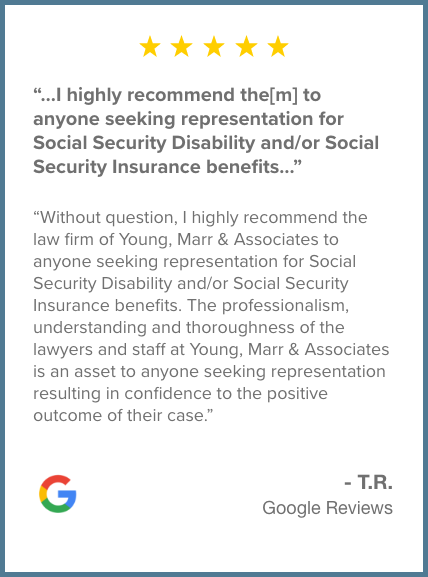Can My Autistic Child Qualify for Disability Benefits in Pennsylvania?
Every parent hopes that their child will grow and develop without presenting for childhood disabilities, conditions or illnesses. However, sometimes a child will develop an impairment such as autism. While the causes of autism have not been fully explained, the condition does have a strong genetic bias. Other proposed explanations for the condition include chemicals likely to cause birth defects and other environmental factors.

However regardless of the cause of the condition, all parents are dedicated to providing supportive care and the resources their child needs to reach his or her potential. Some parents may apply for Social Security Disability benefits that can provide cash payments that can contribute to financing the care for your child. An experienced Social Security Disability attorney from Young, Marr & Associates can assist you and your family in appealing your Social Security Disability denial.
What is considered to be autism?
There are a number of conditions that are subsumed under the categories of Autistic Spectrum Disorders (ASD) or Pervasive Developmental Disorders (PDD). Conditions of this class can cause impairments in social interaction, independent living, and communication. An ASD or PDD condition is typically diagnosed within the first three years of a child’s life. While there are no known cures for autism and related conditions, many individuals affected by the condition can achieve higher levels of functioning after treatment and within a supportive environment.
How will my child’s eligibility be assessed by the Social Security Administration?
When a benefit award is granted to a child with a qualifying disability, those payments are awarded and administered through the Supplemental Security Income (SSI) program until age 18. In determining whether Social Security benefits will be awarded to your child, all Social Security benefit claims proceed through the SSA’s 5-step sequential evaluation process. When the claim is by a child, the process is a 3-step one because a child will not have a work history or current work.
The first step of the evaluation process is concerned with non-medical program requirements. One of these non-medical requirements is that the child must not have exceeded the allowable amount of substantial gainful activity (SGA). For a child the permitted level of SGA is zero. Instances of SGA can include:
- Work or activity for which you receive monetary compensation.
- Work or activity that typically receives monetary compensation
- Activity or endeavors where the goal is to make a profit
To proceed to the next step in the analysis where your child’s medical condition or conditions are evaluated, he or she must be able to satisfy these initial requirements.
Your child’s conditions and impairments are assessed at steps 2 &3
The second step of the sequential evaluation process determines if your child’s condition is one that the SSA would consider to be severe.
At step two of the process, the Social Security Administration determines if your child’s condition can be considered severe. A severe impairment is one that imposes marked or extreme limitations on your child’s ability to function. An impairments that is not severe will not cause the individual to experience functional limitations or will cause only slight limitations in activities. If your child’s autism condition is considered to be severe by the SSA, then the inquiry will proceed to the third and final step in the sequential process.
At Step 3, your condition is compare to a list of conditions that the SSA refers to as “listed conditions”. These listed conditions are contained within the appendix of the SSA’s Blue Book under Part B for childhood conditions. A mere diagnosis of a listed condition, while useful, is not in itself sufficient to receive childhood disability benefits. Rather one must present longitudinal medical and clinical evidence along with reports of daily living from close associates and family members showing that the individual is affected by a listed impairment like:
- Catastrophic Congenital disorder (Listing 110.08)
- Motor dysfunction (Listing 111.06)
- Communication impairment associated with documented neurological disorder (111.09)
- Personality disorders (Listing 112.08)
- Autistic Disorder and other Pervasive Developmental Disorders (Listing 112.10)
To be clear, individuals must inquire into the particular requirements for each listing and compare their child’s condition. If the child’s condition is at least as severe as the listed requirements, he or she is likely to receive benefits.
If your child’s condition does not satisfy the listed criteria, they may be able to still qualify. An alternative means of qualifying for benefits is if the child’s combination of impairments is medically or functionally equal to a Listed condition. To assessing whether a condition would qualify as functionally equivalent, the SAA will consider a broad picture of your child’s ability to function. This picture includes 6 domains, or areas, that the SAA will analyze: ability to care for self, ability to complete tasks, mobility, acquiring & using information, social interactions, and maintaining one’s health and well-being. An equivalent condition is one where there are marked limitations in two or more areas or an extreme limitation in a single domain.
Put our Social Security benefits experience to work for your family
Young, Marr & Associates provides experienced Social Security representation to families who have been impacted by a serious medical impairment. Our attorneys can fight for your family so that your child can receive the supportive care necessary to improve his or her independent functioning. To schedule a legal consultation with a disability lawyer call (800) 850-0491 or contact us online.






























